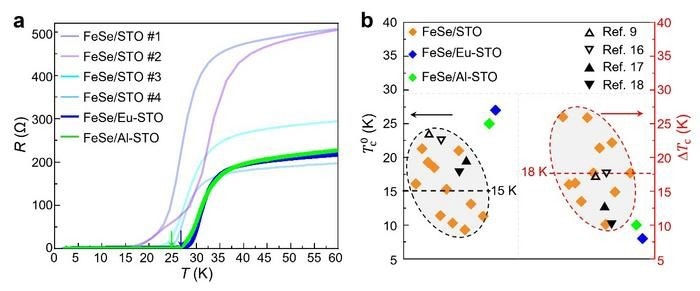Reviewed by Lexie CornerApr 29 2024
In a recent paper published in the journal, National Science Review, researchers from Shaanxi Normal University have successfully discovered new quantum states at the atomic level. FeSe on SrTiO3 substrates has remarkable interface-enhanced superconductivity.
 The transport results of FeSe/δ-doped SrTiO3(001), in comparison with FeSe/SrTiO3(001). Image Credit: Science China Press
The transport results of FeSe/δ-doped SrTiO3(001), in comparison with FeSe/SrTiO3(001). Image Credit: Science China Press
Harnessing interface engineering has demonstrated its efficacy in unveiling novel quantum states, including topological states, superconductivity, charge density waves, and magnetism, necessitating atomic-scale heterostructure fabrication techniques.
Early experimental studies revealed significant interfacial electron transfer from the TiO2-δ charge reservoir layer, with oxygen vacancies acting as intrinsic donors, to the FeSe monolayer.
The cooperative contribution from electron-phonon coupling with specific longitudinal optical phonon modes from TiO2-δ surfaces has been attributed to the monolayer FeSe's additional enlarged gap magnitudes (that is, 15-20 meV vs. 12 meV) compared to other electron-doped FeSe.
The remarkably lower zero-resistance temperature achieved thus far than the gap-opening temperature (65-83 K) has led to claims of incoherent Cooper pairing and pseudogap. Prior characterization of the monolayer FeSe films using scanning tunneling microscopy and spectroscopy revealed dense domains; superconducting gaps are suppressed around domain boundaries and even disappear in domains at the nanometer scale.
The antiferrodistortive phase transition in bulk-SrTiO3 at 105 K is the source of the domains. Historically, attempts to increase the homogeneity of monolayer FeSe have typically come at the expense of decreasing interface coupling or the other way around.
Through metallic δ-doping (Au and Al atoms), Qi-Kun Xue, Lili Wang, and Minghu Pan from Tsinghua University and Shaanxi Normal University reported improved spatial uniformity and interface coupling in monolayer FeSe films on SrTiO3(001), leading to enhanced superconductivity.
Lower work functions with reduced electronic variation show that the Al and Eu atoms, having a higher oxygen affinity than Ti, scavenge oxygen from the TiO2-δ surface, increasing the density of the surface oxygen vacancies while preventing their clustering.
On such δ-doped SrTiO3(001), monolayer FeSe films show reduced domain intensity and generally enlarged superconducting gaps, suggesting enhanced electronic homogeneity and stronger Cooper pairing.
As a result, the temperature-dependent resistivity measurements revealed an onset transition temperature of 53 K and a zero-resistance temperature of 27 K. This work was equally contributed to by Xiaotong Jiao from Shaanxi Normal University, Wenfeng Dong, Dr. Mingxia Shi, and Dr. Heng Wang from Tsinghua University.
Journal Reference:
Jiao, X., et al. (2023) Significantly enhanced superconductivity in monolayer FeSe films on SrTiO3(001) via metallic δ-doping. National Science Review. https://doi.org/10.1093/nsr/nwad213